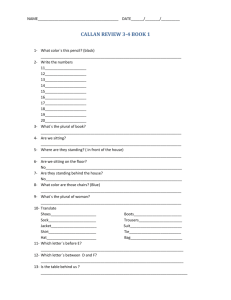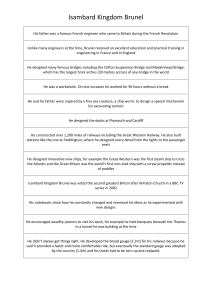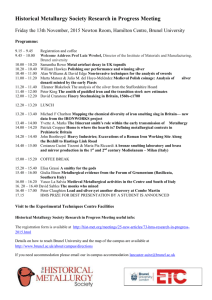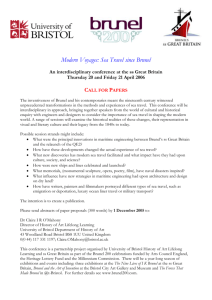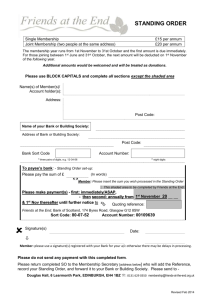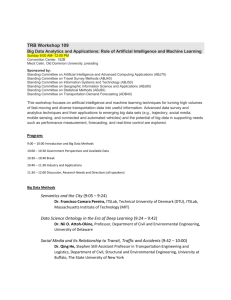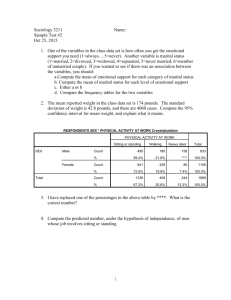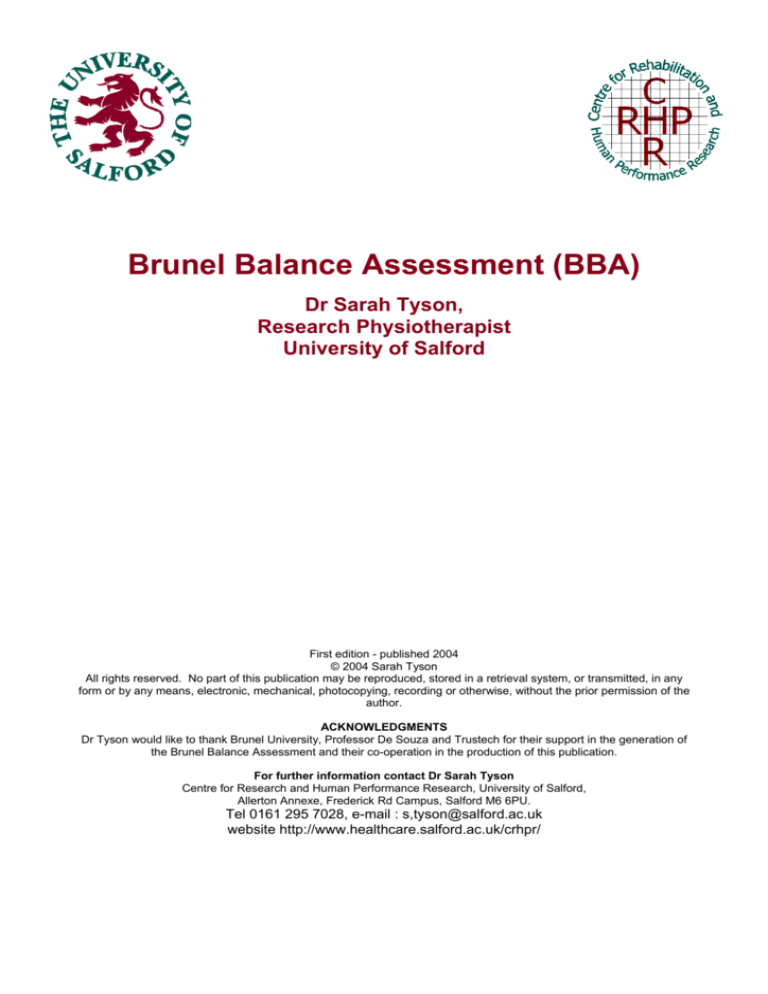
Brunel Balance Assessment (BBA)
Dr Sarah Tyson,
Research Physiotherapist
University of Salford
First edition - published 2004
© 2004 Sarah Tyson
All rights reserved. No part of this publication may be reproduced, stored in a retrieval system, or transmitted, in any
form or by any means, electronic, mechanical, photocopying, recording or otherwise, without the prior permission of the
author.
ACKNOWLEDGMENTS
Dr Tyson would like to thank Brunel University, Professor De Souza and Trustech for their support in the generation of
the Brunel Balance Assessment and their co-operation in the production of this publication.
For further information contact Dr Sarah Tyson
Centre for Research and Human Performance Research, University of Salford,
Allerton Annexe, Frederick Rd Campus, Salford M6 6PU.
Tel 0161 295 7028, e-mail : s,tyson@salford.ac.uk
website http://www.healthcare.salford.ac.uk/crhpr/
Brunel Balance Assessment
CONTENTS
Introduction ........................................................................................................................................3
Development of BBA..............................................................................................................3
How the BBA works ...............................................................................................................3
How to test a patient ................................................................................................................
Case Example using the BBA............................................................................................................4
Brunel Balance Assessment Testing Instructions
Section 1: Sitting
Level 1: Supported sitting ..................................................................................................................7
Level 2: Static sitting balance ............................................................................................................8
Level 3: Dynamic sitting balance .......................................................................................................9
Section 2: Standing11
Level 4: Supported standing ............................................................................................................10
Level 5: Static standing balance ......................................................................................................11
Level 6: Dynamic standing balance .................................................................................................12
Section 3: Stepping
Level 7: Static double stance ...........................................................................................................13
Level 8: Supported single stance.....................................................................................................14
Level 9: Dynamic double stance ......................................................................................................15
Level 10: Changing the base of support between double and single stance ...................................17
Level 11: Dynamic single stance .....................................................................................................18
Level 12: Changing the base of support ..........................................................................................19
Scoring sheet
Brunel Balance Assessment Score Sheet .......................................................................................20
Appendices
Appendix 1: Publications and presentations on the BBA.................................................................21
Appendix 2: References...................................................................................................................22
1
Brunel Balance Assessment
INTRODUCTION
Development of the BBA
The Brunel Balance Assessment (BBA) is designed to assess functional balance for people with a
wide range of abilities and has been tested specifically for use post-stroke.
There are already many ways of measuring balance, but none are suitable for use in the clinical
setting to assess the effects of individual rehabilitation interventions or to measure change over a
short term. Ordinal scales such as the Berg Balance or Motor Assessment Scales lack sensitivity1.
Functional performance tests such as timed walk tests are only suitable for people with a narrow
range of abilities2. Instrumented measures such as weight distribution or postural sway monitors
are expensive, only suitable for a narrow range of abilities and of doubtful reliability and validity3.
The Brunel Balance Assessment has been designed to fulfil the criteria that make it suitable for
using the clinical setting. It is drawn from, and is reflective of, clinical practice4, reliable, valid and
sensitive to change5,6. It is also cheap, quick and simple to use, and it allows the tester to have
their hands free to assist the patient as necessary. It can be used in the hospital bedside,
treatment area or client’s home.
How the BBA works
The BBA consists of a hierarchical series of functional performance tests that range from
supported sitting balance to advanced stepping tasks. There are three sections to the
assessment: sitting, standing and stepping.
Each section can be used either individually or together. The sections are divided into several
levels each of which increase the demand on balance ability, ranging from assisted balance to
moving within the base of support, and changes of the base of support.
At each level, the patient receives a score for his/her efforts. This gives an indication on whether
the patient is improving within a level, even if he/she is not able to progress to the next level. The
score also reflects how well the individual is functioning within that section e.g. sitting, standing or
stepping.
How to test a patient
•
The patient performs each test in turn until they get to the level that is the limit of their
abilities.
•
As the items on the scale are hierarchical, testing can start at a level that is reasonable for
the subject. For example, if you know the subject can walk then you can assume he can
pass all the sitting tests and can start with the standing or stepping tests.
•
For each test there is a minimal level of performance required for the patient to ‘pass’ at
that level.
•
If the patient has been unable to achieve this minimal level after three attempts then testing
should cease.
•
When the patient is unable to progress to the next level, the score within the level can be
used as a measure of performance.
2
Brunel Balance Assessment
CASE EXAMPLE USING THE BBA
Patient history
Mrs S is a 79-year-old woman with an eight-week history of right hemiplegia and sensory
impairment following a left cerebral infarct.
Motricity index for the right leg was 43/100 indicating that she had movement through part of range
but not against gravity in the hip, knee and ankle.
Proprioception in the leg was normal but sensation to light touch was impaired.
She had a Barthel Index was 8/20 indicating severe dependence in activities of daily living (ADL).
Use of the BBA
a)
Baseline assessment
Her initial Brunel Balance Assessment Score was 3/12 indicating that she had dynamic sitting
balance but was unable to stand (Figure 1). This was tested using the sitting forward reach test,
which she passed with a score of 22cm, and this was used as a day-to-day measure of her
progress.
b)
Assessment at one week
A week later her Brunel Balance Assessment score was still 3 but her dynamic sitting balance had
improved as the forward reach score had increased to 42 cm (Figure 2).
c)
Assessment at one month
At reassessment a month later the Brunel Balance Assessment score had improved to 5 indicating
that she had static standing balance and now the standing arm raise test was used as the day-today measure (Figure 3).
3
Brunel Balance Assessment
Figure 1: Baseline assessment
Level
1
Supported Sitting Timed test
2
Static sitting Sitting arm raise
test
Dynamic sitting Sitting forward
reach test
3
4
Supported standing
– Timed test
5
Static standing
balance - Standing
arm raise test
Dynamic standing Standing forward
reach test
6
7
8
9
Static double
stance Timed step
standing test
Supported single
stance - walking
with an aid
Score
Attempt number:
1
2
40 s
N/A
9 lifts
24
cm
23
cm
22 cm
10s
N/A
N/A
N/A
N/A
30s
Support
required
Pass
(Y/N)
Pass criteria
(after up to 3
attempts)
Sit supported for 30s
3
N/A
Y
N/A
Y
3 or more arm lifts in
15s
Y
Reach forward more
than 7cm
(average of 2
readings)
Stand supported for
30s
N/A
N/A
N/A
20s
N
3 or more arm lifts in
15s
Reach forward more
than 5cm
(average of 2
readings)
Static step standing
for 30s
Walk 5m within 1min
(average of 2
readings)
Dynamic double
stance - Weight
shift test
Changing base of
support - walking
without an aid
Walk 5m within 1min
(average of 2
readings)
11
Dynamic single
stance - Tap test
2 or more taps within
15s
12
Changing the base
of support - Stepup test
1 or more step-up(s)
within 15s
10
3 or more shifts
within 15s
4
Brunel Balance Assessment
Figure 2: Assessment at 1 week
Level
1
Supported Sitting Timed test
2
Static sitting Sitting arm raise
test
Dynamic sitting Sitting forward
reach test
3
4
Supported standing
– Timed test
5
Static standing
balance - Standing
arm raise test
Dynamic standing Standing forward
reach test
6
7
8
9
Static double
stance Timed step
standing test
Supported single
stance - walking
with an aid
Score
Attempt number:
1
2
50s
N/A
11 lifts
43
cm
47
cm
45 cm
15s
N/A
N/A
N/A
N/A
20s
Pass
(Y/N)
Pass criteria
(after up to 3
attempts)
Sit supported for 30s
3
N/A
Y
N/A
Y
3 or more arm lifts in
15s
Y
Reach forward more
than 7cm
(average of 2
readings)
Stand supported for
30s
N/A
N/A
N/A
20s
N
3 or more arm lifts in
15s
Reach forward more
than 5cm
(average of 2
readings)
Static step standing
for 30s
Walk 5m within 1min
(average of 2
readings)
Dynamic double
stance - Weight
shift test
Changing base of
support - walking
without an aid
Walk 5m within 1min
(average of 2
readings)
11
Dynamic single
stance - Tap test
2 or more taps within
15s
12
Changing the base
of support - Stepup test
1 or more step-up(s)
within 15s
10
3 or more shifts
within 15s
5
Brunel Balance Assessment
Figure 3: Assessment at 1 month
Level
1
Supported Sitting Timed test
2
Static sitting Sitting arm raise
test
Dynamic sitting Sitting forward
reach test
3
4
Supported standing
– Timed test
5
Static standing
balance - Standing
arm raise test
Dynamic standing Standing forward
reach test
6
7
8
9
Static double
stance Timed step
standing test
Supported single
stance - walking
with an aid
Score
Attempt number:
1
2
70s
N/A
9 lifts
40
cm
44
cm
N/A
N/A
N/A
Pass
(Y/N)
Pass criteria
(after up to 3
attempts)
Sit supported for 30s
3
N/A
Y
N/A
Y
3 or more arm lifts in
15s
Y
Reach forward more
than 7cm
(average of 2
readings)
Stand supported for
30s
N/A
N/A
42 cm
50s
N/A
N/A
N/A
N/A
Y
5
Support
required
4
4
cm
cm
4cm
7
N/A
Y
3 or more arm lifts in
15s
N
Reach forward more
than 5cm
(average of 2
readings)
Static step standing
for 30s
4cm
5cm
4.5cm
3cm
5cm
4cm
Walk 5m within 1min
(average of 2
readings)
Dynamic double
stance - Weight
shift test
Changing base of
support - walking
without an aid
Walk 5m within 1min
(average of 2
readings)
11
Dynamic single
stance - Tap test
2 or more taps within
15s
12
Changing the base
of support - Stepup test
1 or more step-up(s)
within 15s
10
3 or more shifts
within 15s
6
Brunel Balance Assessment
BRUNEL BALANCE ASSESSMENT TESTING INSTRUCTIONS
SECTION 1: SITTING
Level 1: Supported sitting –Timed Test
Summary
In this test, the subject is asked to sit with upper limb support (i.e. taking weight through their arms
or holding on) for at least 30 seconds.
Equipment: Plinth or suitable seating
Stop watch
Instructions
1. The subject is seated on a firm, level surface without back support and their feet flat on the
floor. They can use upper limb support if they wish. Stand beside the subject to give support
if necessary.
2.
Explain the test to the subject:
“I want to time how long you can sit without me helping you. You can use your arms to
support yourself if you wish. When I say GO try to keep your balance for as long as
you can or until I say stop.”
3.
Use the stop-watch to time how long they can maintain sitting balance for up to 30 seconds.
Call out the time every 10 seconds.
4.
Note the time and decide whether to pass or fail:
Subject keeps his/her balance for 30 seconds or more, with (upper limb) support
Pass
but without assistance from the tester
Fail
Subject keeps his/her balance for less than 30 seconds, and/or requires
assistance from the tester
5. If subject fails, repeat the test once or twice more. If the subject passes the test by the third
attempt, proceed to the next level.
30s
7
Brunel Balance Assessment
SECTION 1: SITTING
Level 2: Static sitting balance - Sitting Arm Raise Test
Summary
In this test, the subject is asked to maintain his/her position while raising and lowering his/her
sound arm (Arm Raise Test) for 15 seconds.
Equipment: Plinth or suitable seating
Stop watch
Instructions
1. The subject is seated on a firm, level surface without back support, feet flat on the floor and
hands resting on lap. Stand beside the subject to give support if necessary.
2. Explain and demonstrate the movement to the subject, get them to practise it and correct as
necessary:
"I want to see how many times you can lift your sound arm up and down in 15
seconds. When I say GO raise and lower your arm as often as you can, until I say
stop”.
3. Use the stop-watch to time 15 seconds. Count the number of times the subject can raise
his/her sound arm (his/her maximum shoulder flexion) and return it back to their sound
knee.
4. Note the score and decide whether to pass or fail:
Subject performs 3 or more arm lifts*
Pass
Fail
Subject performs less than 3 arm lifts*
* A lift does not count if the subject does not achieve full flexion (for him/her), needs to ‘touch
down' (i.e. places hand somewhere other than the sound knee to keep his/her balance), and/or
he/she requires support and/or assistance from the tester.
5. If the subject fails, repeat the test once or twice more. If the subject passes the test by the third
attempt, proceed to the next level.
15s
8
Brunel Balance Assessment
SECTION 1: SITTING
Level 3: Dynamic sitting balance - Sitting Forward Reach Test
Summary
In this test, the subject is asked to move to his/her limits of stability within the base of support while
sitting down (Forward Reach Test). The distance the subject can reach forward beyond arm's
length is measured.
Equipment: Plinth or suitable seating
1m ruler on adjustable height stand
Instructions
1. The subject is seated with hips at 90 degrees on a firm, level surface without back support, feet
flat on the floor and hands resting on lap. Stand beside the subject to give support if
necessary.
2. The height of the ruler is adjusted so that it is at the level of the acromion of the sound
shoulder. The subject lifts his/her sound arm to shoulder height with fingers curled into a fist
while sitting in a normal, comfortable position. Position the ruler so that the end of the ruler
touches the knuckles of the outstretched arm and it continues in a forward direction.
3. The subject reaches forwards as far as possible with their hand level with the ruler. When at
maximum reach, the tester reads the position of the knuckle of the middle finger from the ruler.
4. Explain and demonstrate the movement to the subject, get them to practice it and correct as
necessary:
"I want you to reach forwards as far as you can, keeping your hand level with the ruler.
When you are at full stretch hold the position for a few seconds while I read the ruler
then sit back. Keep your feet on the ground, and your bottom on the seat, do not use
your weak arm for support.
5. Read and note the position of the knuckle of the middle finger on the ruler.
6. Repeat this test. Note the second value and take an average of the two scores. Decide
whether to pass or fail:
Average value is 7cm or more, without upper limb support and/or assistance
Pass
from the tester
Average value is less than 7cm, and/or the subject requires upper limb support
Fail
and/or assistance from the tester
7. If subject fails, repeat the test once or twice more. If the subject passes the test by the third
attempt, proceed to the next level.
9
Brunel Balance Assessment
SECTION2: STANDING
Level 4: Supported standing - Timed Test
Summary
In this test, the subject is asked to stand with upper limb support, holding on to furniture or a plinth
for at least 30 seconds.
Equipment: Plinth or suitable furniture for the subject to hold on to
Stop-watch
Instructions
1. The subject stands on a firm, level surface in normal shoes with feet in a comfortable, level
position, and holding on to furniture if necessary. Provide support at waist height in front or to
the sound side e.g. a plinth, bedside cupboard or back of a chair. Stand beside the subject to
give assistance as necessary.
2. Explain the test to the subject:
"I want to time how long you can stand without me helping you. You can hold on if you
wish. When I say GO try to keep your balance for as long as you can or until I say
stop."
3. Use the stop-watch to time how long the subject can maintain standing balance for up to 30
seconds. Call out the time every 10 seconds.
4. Note the time and decide whether to pass or fail:
Subject keeps his/her balance for 30 seconds or more, with or without support
Pass
and without assistance from the tester
Fail
Subject keeps his/her balance for less than 30 seconds, and/or requires
assistance from the tester
5. If subject fails, repeat the test once or twice more. If the subject passes the test by the third
attempt, proceed to the next level.
30s
10
Brunel Balance Assessment
SECTION 2: STANDING
Level 5: Static standing balance - Standing Arm Raise Test
Summary
In this test, the subject is asked to maintain his/her position within the base of support while raising
and lowering his/her sound arm (Arm Raise Test) for 15 seconds.
Equipment: Stop-watch
Instructions
1. The subject stands on a firm, level surface with feet level without upper limb support. Stand
beside the subject to give support. Explain and demonstrate the movement to the subject,
practice and correct as necessary.
2.
Explain the test to the subject:
"I want to count how many times you can lift your sound arm in 15 seconds. When I
say GO raise and lower your sound arm as often as you can, until I say stop.”
3.
Use the stop-watch to time 15 seconds. Count the number of times the subject can raise
(his/her maximum shoulder flexion) and lower their sound arm (to their side) in this time.
4.
Note the score and decide whether to pass or fail:
Subject performs 3 or more arm lifts*
Pass
Fail
Subject performs less than 3 arm lifts*
* A lift does not count if the subject does not achieve full flexion (for him/her), needs to ‘touch
down' (i.e. places hand somewhere other than the sound knee to keep his/her balance), and/or
he/she requires support and/or assistance from the tester.
5.
If subject fails, repeat the test once or twice more. If the subject passes the test by the third
attempt, proceed to the next level.
15s
11
Brunel Balance Assessment
SECTION 2: STANDING
Level 6: Dynamic Standing balance - Standing Forward Reach Test
Summary
In this test, the subject is asked to move to his/her limits of stability within the base of support while
standing (Forward Reach Test). The distance the subject can reach forward beyond arm's length
is measured.
Equipment: 1m ruler attached to adjustable height stand
Stop-watch
Instructions
1. The subject stands on a firm, level surface with feet level without upper limb support. Stand
beside the subject to give support.
2. The height of the ruler is adjusted so that it is at the level of the acromion of the sound
shoulder. The subject lifts his/her sound arm to shoulder height with fingers curled into a fist.
3. Position the ruler so that the knuckles of the outstretched arm are level with the end of the
ruler, and the ruler points forwards in front of the subject.
4. The subject reaches forwards as far as possible with their hand level with the ruler. When at
maximum reach the tester reads the position of the knuckle of the middle finger from the ruler
.
5. Explain and demonstrate the movement to the subject, get them to practice and correct as
necessary:
"I want you to reach forwards as far as you can with your hand level with the ruler.
When at full stretch hold the position for a few seconds while I read the ruler, then
return to upright. Keep your heels on the ground and do not use your weak arm for
support.”
6. Note the ruler reading.
7. Repeat the measurement and take an average of the two scores. Decide whether to pass or
fail:
Average value is 5cm or more, without upper limb support and/or assistance from
Pass
the tester
Average value is less than 5cm, and/or the subject requires upper limb support
Fail
and/or assistance from the tester
8. If subject fails, repeat the test once or twice more. If the subject passes the test by the third
attempt, proceed to the next level.
12
Brunel Balance Assessment
SECTION 3: STEPPING
Level 7: Static double stance - Timed step-standing test
Summary
In this test, the subject is asked to maintain a step-standing position without upper limb support for
at least 30 seconds.
Equipment
Stop-watch
Instructions
1. The subject stands without upper limb support on a firm, level surface in step standing position
(sound foot in front of weak foot, with sound heel level or beyond the toes of the weak foot,
both knees extended). Stand beside the subject to give support.
2. Explain the test to the subject, demonstrate and practise as necessary:
“I want to time how long you can stand without me helping you. Keep your arms by
your sides. When I say GO try to keep your balance for as long as you can or until I say
stop.”
3. Use the stop-watch to time how long they can maintain the step standing position for up to 30
seconds. Call out the time every 10 seconds.
4. Note the time and decide whether to pass or fail:
Subject keeps his/her balance for 30 seconds or more, without support and/or
Pass
assistance from the tester
Fail
Subject keeps his/her balance for less than 30 seconds, and/or requires support
and/or assistance from the tester
5. If subject fails, repeat the test once or twice more. If the subject passes the test by the third
attempt, proceed to the next level.
30s
13
Brunel Balance Assessment
SECTION 3: STEPPING
Level 8: Supported single stance - Walking with an aid
Summary
In this test, the subject is asked to walk without assistance, although he/she may use a walking aid
(5 metres Walk Test with an aid).
Please note: If the subject is already able to walk without an aid, pass this level and progress to
level 9.
Equipment
Tape to mark 5m ‘walkway’ on the floor
Stop-watch
Instructions
1. A distance of 5 metres is marked on the floor. The subject starts to walk a couple of strides
before the ‘start line’ and does not stop until he/she has crossed the ‘finish line’. Stand/walk
beside the subject to give support.
2. Explain and demonstrate the test as necessary:
“I am going to time how fast you walk. Walk at your natural pace between these two
markers. Do not slow down until you have crossed the finish line. Start when I say
GO.”
3. Use the stop-watch to time how long it takes to walk this distance and note the time.
4. Repeat the test and take an average of the two scores. Decide whether to pass or fail:
Average value is 1 minute or less, without physical support from the tester
Pass
Fail
Average value is more than 1 minute, and/or the subject requires physical support
from the tester
5. If subject fails, repeat the test once or twice more. If the subject passes the test by the third
attempt, proceed to the next level
.
14
Brunel Balance Assessment
SECTION 3: STEPPING
Level 9: Dynamic double stance - Weight Shift Test
Summary
In this test, the subject is asked to move within the base of support in a step-standing position
repeatedly transferring his/her weight on and off the weak leg (Weight Shift Test) for 15 seconds.
Equipment
Two perching stools, Walking frames or chairs
Stop-watch
Instructions
1. Starting position: The subject stands without upper limb support on a firm, level surface in stepstanding position (weak foot in front, with weak heel level or beyond the sound toes). A
perching stool or walking frame (or similar) adjusted to hip/tummy height is positioned so that
the horizontal bar is over the 5th metatarsal of the weak foot. Another frame or stool is
positioned behind the subject at hip/ bottom level, so their bottom touches the stool when their
weight is on the sound leg. Stand beside the subject to give support as necessary.
Movement: The subject transfers his/her weight onto the weak leg so that his/her tummy
touches the back of the stool, and then back on to the sound leg so that their bottom touches
the other stool. The subject needs to stand upright and keep his/her hips neutral/extended.
The sound heel may lift as weight is transferred forwards but it must be on the floor when
weight bearing.
2. Explain and demonstrate the test, practise and correct as necessary:
“I want to count how many times you can transfer your weight from one leg to the other
and back again. When I say GO transfer your weight on to the weak leg so that your
tummy touches the stool/frame, then back on to the sound leg so that your bottom
touches the other stool/frame. Keep your hips and knees straight when your weight is
on the leg, but your can bend your sound knee and raise your heel as you bring your
weight forwards. Do this as many times as you can until I say stop.”
3. Use the stop-watch to time 15 seconds, and count the number of times the subject touches the
bar of the frame at the front, i.e. how often they transfer their weight on to the weak foot.
4. Note the score and decide whether to pass or fail:
Subject performs 3 or more transfers*
Pass
Fail
Subject performs less than 3 transfers*
*A transfer does not count if the subject does not touch the stool/frame at front or back, uses
upper limb support, and/or requires support and/or assistance from the tester.
5. If subject fails, repeat the test once or twice more. If the subject passes the test by the third
attempt, proceed to the next level.
15
Brunel Balance Assessment
1.
15s
2.
3.
16
Brunel Balance Assessment
SECTION 3: STEPPING
Level 10: Changing the base of support between double and single stance - Walking
without an aid
Summary
In this test, the subject is asked to walk without assistance or a walking aid for 5 metres (5 metres
Walk Test).
Equipment
Tape to mark 5m ‘walkway’ on the floor
Stop-watch
Instructions
1. A distance of 5 metres is marked on the floor. The subject starts to walk a couple of strides
before the ‘start line’ and does not stop until he/she has crossed the ‘finish line’. Stand/walk
beside the subject to give support.
2. Explain and demonstrate the test as necessary:
“I am going to time how fast you walk. Walk at your natural pace between these two
markers. Do not slow down until you have crossed the finish line. Start when I say
GO.”
3. Use the stop-watch to time how long it takes to walk this distance. Note the time.
4. Repeat the test and take an average of the two scores. Decide whether to pass or fail:
Average value is 1 minute or less, without physical support from the tester
Pass
Fail
Average value is more than 1 minute, and/or the subject requires physical support
from the tester
5. If subject fails, repeat the test once or twice more. If the subject passes the test by the third
attempt, proceed to the next level.
17
Brunel Balance Assessment
SECTION 3: STEPPING
Level 11: Dynamic single stance - Tap Test
Summary
In this test, the subject is asked to maintain single stance on the weak leg while moving the other
leg repeatedly placing his/her sound leg on and off a step while standing on the weak leg (StepTap Test) for 15 seconds.
Equipment
‘Step-up’ block or step 7.5-10cm high
Stop-watch
Instructions
1. The subject stands on a firm level surface with feet level. A 7.5-10 cm high block is positioned
a hands width (10cm) in front of his/her toes. The subject places his/her sound foot on and off
the block as often as possible within 15 seconds (but does not step up). The subject should
place his/her whole foot on the block. Stand beside the subject to give support.
2. Explain and demonstrate the test, practise and correct as necessary:
“I want to count how many times you can place your sound foot on and off this block,
without stepping up onto the block. When I say GO put your sound foot onto the block
and then take it off again. Do this as many times as you can until I say stop.”
3. Use the stop-watch to time 15 seconds, and count aloud the number of steps the subject
performs.
4. Note the score and decide whether to pass or fail:
Pass
Subject performs 2 or more foot steps*
Fail
Subject performs less than 2 foot steps*
* A step does not count if the subject uses upper limb support, and/or requires support and/or
assistance from the tester.
5. If subject fails, repeat the test once or twice more. If the subject passes the test by the third
attempt, proceed to the next level.
15
18
Brunel Balance Assessment
SECTION 3: STEPPING
Level 12: Changing the base of support - Step-up Test
Summary
In this test, the subject is asked to change his/her base of support by stepping up on to and off a
block, leading with his/her weak leg (Step-Up Test) for 15 seconds.
Equipment
‘Step-up’ block or step 7.5-10cm high
Stop-watch
Instructions
1. The subject stands on a firm level surface with feet level. A 7.5-10cm high block is positioned
a hands width (10cm) in front of his/her toes. The subject steps up, onto, and off the block
leading with their weak leg as often as possible within 15 seconds. A step-up is completed
when weak leg is placed on the floor again. Stand beside the subject to give support.
2. Explain and demonstrate the test, practise and correct as necessary:
“I want you to step up on to the block and then off again, leading with your weak leg.
When I say GO do this as often as you can until I say stop.”
3. Use the stop-watch to time 15 seconds, and count the number of steps-up performed.
4. Note the score and decide whether to pass or fail:
Pass
Subject performs 1 or more step up and down*
Fail
Subject performs less than 1 step up and down*
* A step up and down does not count if the subject uses upper limb support, and/or requires
support and/or assistance from the tester.
5. If subject fails, repeat the test once or twice more.
15
19
Brunel Balance Assessment
SCORE SHEET
Subject details:
(Place sticker here)
Name of Tester: ___________________________
Level
Score
Attempt number:
1
2
1
Supported Sitting Timed test
2
Static sitting Sitting arm raise
test
Dynamic sitting Sitting forward
reach test
3
4
Supported standing
- Timed test
5
Static standing
balance - Standing
arm raise test
Dynamic standing Standing forward
reach test
6
7
8
9
10
11
12
Date of Test: _____________
Pass
(Y/N)
3
Static double
stance Timed step
standing test
Supported single
stance - walking
with an aid
Pass criteria
(after up to 3
attempts)
Sit supported for 30s
3 or more arm lifts in
15s
Reach forward more
than 7cm
(average of 2
readings)
Stand supported for
30s
3 or more arm lifts in
15s
Reach forward more
than 5cm
(average of 2
readings)
Static step standing
for 30s
Walk 5m within 1min
(average of 2
readings)
Dynamic double
stance - Weight
shift test
Changing base of
support - walking
without an aid
3 or more shifts
within 15s
Dynamic single
stance - Tap test
2 or more taps within
15s
Changing the base
of support - Stepup test
Use “S” to denote that support/assistance was required from the tester
Walk 5m within 1min
(average of 2
readings)
1 or more step-up(s)
within 15s
20
Brunel Balance Assessment
APPENDIX 1
Publications and presentations on the Brunel Balance Assessment:
Tyson S & DeSouza L (2004). Development of the Brunel Balance Assessment; A new measure of
balance disability post-stroke Clinical Rehabilitation 8;7;801-810
Tyson S & DeSouza L (2004). Reliability and Validity of functional balance tests post-stroke.
Clinical Rehabilitation (18;7 in press)
Tyson S & Desouza L (2003). Measurement error of sitting balance tests post-stroke.
Physiotherapy Research Society, Winter Meeting, Oxford
Tyson S & DeSouza L (2003). The Brunel Balance Assessment: A new measure of balance
disability post-stroke. 14th World Congress of Physical Therapy, Barcelona , Spain
Tyson S & DeSouza L (2002). Reliability and Validity of the Brunel Balance Assessment. 13th
European Congress of Physical Medicine and Rehabilitation Brighton, UK.
Tyson S & DeSouza L (2002). The Brunel Standing Balance Tests. Physiotherapy Research
Society Spring 2002, Keele University, UK.
Tyson SF & DeSouza L. (2002). The sitting balance tests of the Brunel Balance Assessment.
Society of Research in Rehabilitation, Winter Meeting University of East London.
Tyson SF & DeSouza L (2001). Development of the Brunel Balance Assessment. Presented at
Society of Research in Rehabilitation. Summer meeting, University of Manchester. Proceedings in
Clinical Rehabilitation 2002;16, 2;229.
APPENDIX 2
References
1. Tyson S & DeSouza L (2002). Measurement of balance and walking post-stroke: Part 1 Ordinal
Scales. Physical Therapy Reviews 2002;7;3;177-85
2. Tyson S & DeSouza L (2002). Measurement of balance and walking post-stroke: Part 2
Functional Performance Tests. Physical Therapy Reviews 2002;7;3;87-91
3. Tyson S & DeSouza L (2003). Measurement of balance post-stroke: Part 3 Instrumented
Measurement Tools Physical Therapy Reviews 2002;7;4;231-241
4. Tyson S & Desouza L (2003). A clinical model for the assessment of posture and balance poststroke. Disability and Rehabilitation 25;3;120-127
5. Tyson S & DeSouza L (2004). Development of the Brunel Balance Assessment; A new measure
of balance disability post-stroke Clinical Rehabilitation 8;7;801-810
6. Tyson S & DeSouza L (2004). Reliability and Validity of functional balance tests post-stroke.
Clinical Rehabilitation (18;7 in press)
21

